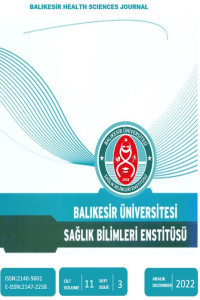Çocuklarda Ağız Solunumu Sendromuna Bağlı Faktörlerin Değerlendirilmesi
ağız solunum sendromu, burun solunumu, çocuk
Evaluation of Factors Related to Mouth Breathing Syndrome in Children
mouth breathing syndrome, nasal breathing, child,
___
- Referans1. Kluemper, G.T. (2004). A fairly severe mouth breathing habit. Am. J. Orthop. 125(1):18A-19A.
- Referans2. Inada, E., Saitoh, I., Kaihara, Y., & Yamasaki, Y. (2021). Factors related to mouth-breathing syndrome and the influence of an incompetent lip seal on facial soft tissue form in children. Pediatric Dental Journal, 31(1), 1-10.
- Referans3. Harari, D., Redlich, M., Miri, S., Hamud, T., & Gross, M. (2010).The effect of mouth breathing versus nasal breathing on dentofacial and craniofacial development in orthodontic patients. The Laryngoscope, 120(10), 2089-2093.
- Referans4. Souki, B. Q., Pimenta, G. B., Souki, M. Q., Franco, L. P., Becker, H. M., & Pinto, J. A. (2009). Prevalence of malocclusion among mouth breathing children: do expectations meet reality?. International journal of pediatric otorhinolaryngology, 73(5), 767-773.
- Referans5. Nascimento Filho, E., Mayer, M. P. A., Pontes, P., Pignatari, A. C. C., & Weckx, L. L. M. (2004). Caries prevalence, levels of mutans streptococci, and gingival and plaque indices in 3.0-to 5.0-year-old mouth breathing children. Caries research, 38(6), 572.
- Referans6. Okuro, R. T., Morcillo, A. M., Oliveira Ribeiro, M. Â. G., Sakano, E., Margosian Conti, P. B., & Ribeiro, J. D. (2011). Mouth breathing and forward head posture: effects on respiratory biomechanics and exercise capacity in children. Jornal Brasileiro de Pneumologia, 37(4).
- Referans7. Chervin, R. D., Ruzicka, D. L., Archbold, K. H., Dillon, J. E. (2005). Snoring predicts hyperactivity four years later. Sleep, 28(7), 885-890.
- Referans8. Huynh, N. T., Morton, P. D., Rompre, P. H., Papadakis, A., & Remise, C. (2011). Associations between sleep-disordered breathing symptoms and facial and dental morphometry, assessed with screening examinations. American journal of orthodontics and dentofacial orthopedics, 140(6), 762-770.
- Referans9. Kukwa, W., Guilleminault, C., Tomaszewska, M., Kukwa, A., Krzeski, A., & Migacz, E. (2018). Prevalence of upper respiratory tract infections in habitually snoring and mouth breathing children. International journal of pediatric otorhinolaryngology, 107, 37-41.
- Referans10. Stensson, M., Wendt, L. K., Koch, G., Nilsson, M., Oldaeus, G., & Birkhed, D. (2010). Oral health in pre‐school children with asthma–followed from 3 to 6 years. International journal of paediatric dentistry, 20(3), 165-172.
- Referans11. Saitoh, I., Inada, E., Kaihara, Y., Nogami, Y., Murakami, D., Kubota, N., ... & Yamasaki, Y. (2018). An exploratory study of the factors related to mouth breathing syndrome in primary school children. Archives of oral biology, 92, 57-61.
- Referans12. Motta, L. J., Bachiega, J. C., Guedes, C. C., Laranja, L. T., & Bussadori, S. K. (2011). Association between halitosis and mouth breathing in children. Clinics, 66(6), 939-942.
- Referans13. Alqutami, J., Elger, W., Grafe, N., Hiemisch, A., Kiess, W., & Hirsch, C. (2019). Dental health, halitosis and mouth breathing in 10-to-15 year old children: A potential connection. European Journal of Paediatric Dentistry, 20(4), 274.
- Referans14. Cabrera, L. D. C., Retamoso, L. B., Mei, R. M. S., & Tanaka, O. (2013). Sagittal and vertical aspects of Class II division 1 subjects according to the respiratory pattern. Dental Press Journal of Orthodontics, 18(2), 30-35.
- Referans15. Felcar, J. M., Bueno, I. R., Massan, A. C. S., Torezan, R. P., & Cardoso, J. R. (2010). Prevalence of mouth breathing in children from an elementary school. Ciencia & saude coletiva, 15(2), 427.
- Referans16. Ikenaga, N., Yamaguchi, K., & Daimon, S. (2013). Effect of mouth breathing on masticatory muscle activity during chewing food. Journal of oral rehabilitation, 40(6), 429-435.
- Referans17. Hsu, H. Y., & Yamaguchi, K. (2012). Decreased chewing activity during mouth breathing. Journal of oral rehabilitation, 39(8), 559-567.
- ISSN: 2146-9601
- Yayın Aralığı: Yılda 3 Sayı
- Başlangıç: 2012
- Yayıncı: Balıkesir Üniversitesi
Arteria Occipitalis’in Morfometrik Değerlendirilmesi
Emrah ÖZCAN, Esma DERİNÖZ, Bahar KEYİK, Ömür KARACA, Tuğba GİRGİN, İlter KUŞ, Alper VATANSEVER
Zeynep ÖZTÜRK, Meyreme AKSOY, Gülcan BAHÇECİOĞLU TURAN
Asli KURTGÖZ, Zehra İNCEDAL SONKAYA, Selin KESKİN
Gönül TEKKURŞUN DEMİR, Halil İbrahim CİCİOĞLU
Sosyal Medya Kullanımının Klinik Yansımaları: Pediatri Hemşirelerinde Bir İnceleme
Waldeyer Halkası Lenfomalarının Klinikopatolojik İncelenmesi: Türkiye’de Kesitsel Bir Çalışma
Çiğdem ÖZDEMİR, Nilhan ERYEĞEN, Filiz YAVAŞOĞLU, Mehmet Olgun AK, Selçuk KUZU, Mustafa DURAN, Burcu BELEN AYDOĞMUŞ, Büşra ÇETİNKAYA, Abdulkadir BUCAK, Yiğit ŞENOL
Mesiya AYDIN, İlknur AYDIN AVCI
Aile Hekimlerinin Anafilaksi Teşhisi ve Tedavisine İlişkin Hazırlık ve Bilgi Düzeyleri
Mahir SERBES, Sanem NEMMEZİ KARACA
Sağlık Uygulamalarında Sağlık İnancının Etkisi: Hemşirelerde El Hijyeni Örneği
